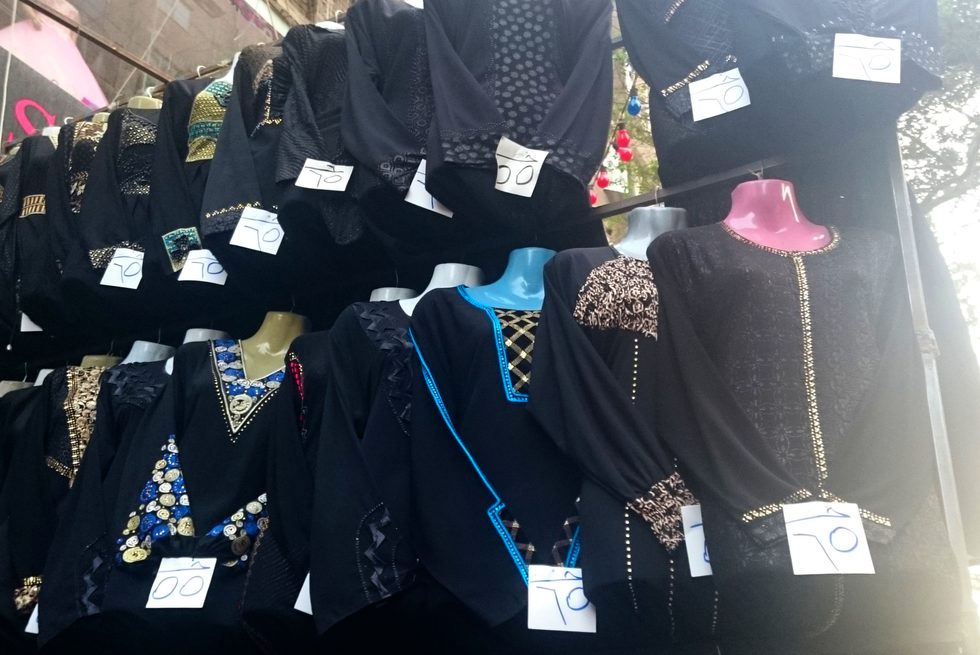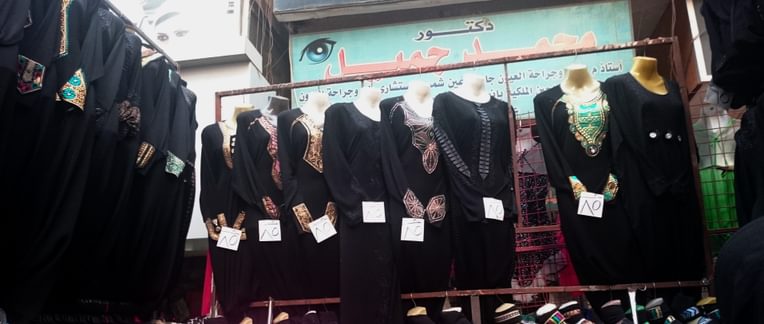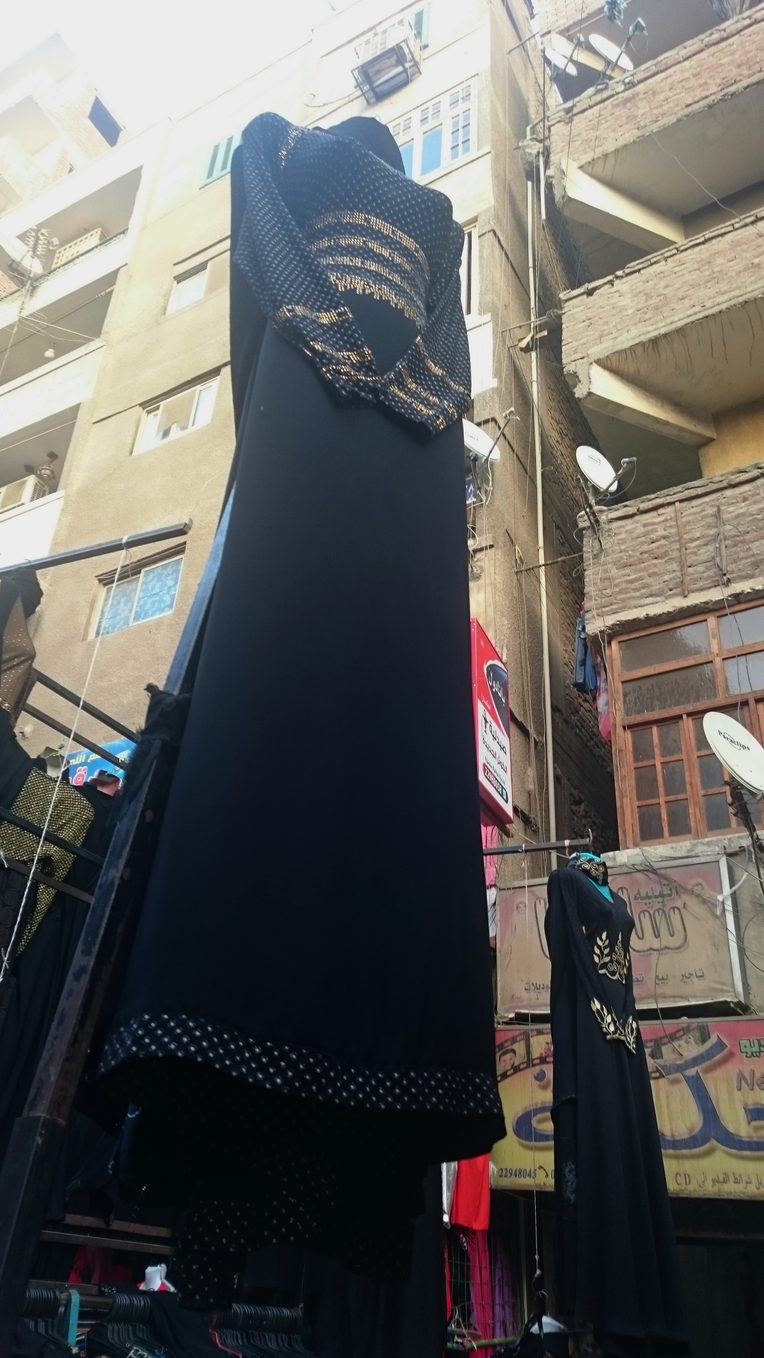
Typically floor-length, black, and loose, abayas are dresses worn by women of working, middle, and upper classes in Egypt and other regions in the world. Convenient and usually affordable, abayas are a popular choice of dress for many women, including myself on some occasions. Far from being a one-size-fits-all staple, however, abayas are worn for reasons that vary along the textures of social class and age: some wear abayas out of ideological resistance, others out of convenience, and, for a few, out of patriarchal transgression.
Read and woven in conversation, this essay features the biographies of three Egyptian women in order to question the homogeneity of discourses about abayas as a form of modest Islamic dress. While abayas are often reduced to reasons of patriarchy, religious ideology, or class conflict, women like Fadila, Nahla, and Hend challenge overly reductive discourses of Egyptian and Muslim feminine dress as a means of paternal control or dogmatic modesty. Instead, they point to the textural multiplicities of women’s experiences and choices in wearing abayas.
Crafted as textural canvases, abayas can instead be understood through a focus on personal choices, trajectories, and culturally specific social realities. Black, tightened, and adorned, abayas in contemporary Egypt narrate biographies of shifting loyalties, resistances, and convenience along gender and social class lines. Further, this allowed me to refuse to rely on gatekeeping concepts such as modesty, patriarchy, or ideologies to make sense of abayas, those which tend to reduce abayas to a set of scripts with little room for multiplicity. Instead, I rely on the narrative biographies of my interlocutors as they choose, strategize, and maneuver their black textural canvases among families, friends, and social circles.

Fadila: An Abaya, a Denim Jacket, and Timberland Boots
Fadila confidently walked around the American University in Cairo campus, where I spotted her between our undergraduate classes as we exchanged smiles and awkward almost-hugs. We are friends, but not very close. A sharp twenty-year-old woman with defined facial features and an outspoken persona, Fadila always wears black abayas and veils, coupled with denim jackets, Adidas Superstar sneakers, or Timberland boots. Intrigued by her style, I asked Fadila if she would be up to a chat over coffee to discuss her choice of wearing abayas and what they mean for her, and she agreed to speak with me.
On the awaited day of our interview, I walked with Fadila to a nearby coffee shop in New Cairo, the bourgeois outskirts of the urban city. Fadila spoke of her nuclear family, sharing how her parents were not very religious and got divorced when she was young. However, after their divorce, Fadila’s mother became more religious and began wearing a hijab and then a niqab (face veil) shortly after. Once she hit puberty, Fadila took steps in her public display of piety: wearing a hijab, then loose pants and skirts, and finally donning abayas, each perceived as a more modest form of dress denoting piety and closeness to God. Fadila’s father was unconvinced by Fadila’s choices, as he thought her mother had brainwashed Fadila into religious extremism. Aware of her father’s stance, which resonated in every social gathering with her upper-middle-class extended family, Fadila decided to resist social norms that saw abayas as a form of oppression or attire of the aging and working classes:
I once came home to find my grandmother having her school friends over for lunch. All my grandmother’s friends are upper-class aristocrats who never thought of veiling. I greeted them in my black abaya as they looked at me in surprise and disbelief: What have I done to myself and what am I wearing? Furious and determined, I went up to my room, took a shower, then wore a sleeveless short dress and went back downstairs. Everyone was so happy and told me that this is how I should always look, instead of this bleak abaya, only adding years to my age and ugliness to my looks. I took thirty minutes, lecturing them that this is my choice and decision. They all dropped their jaws and went blank, while I left the room in pride.
Fadila’s upper-class family members reproduced a “social gaze” through their concern that Fadila does not look bourgeois, attractive, or cheerful enough for their social class standards. While cognizant of these interlocking concerns of the haunting social gaze, Fadila still made a liberating meaning out of wearing black abayas as an upper-middle-class woman. She drew on these discourses and turned them on their head through being a decidedly religious woman whose abayas freed her from particular social expectations around class.

Nahla: On Convenience and Domestic Laborers
A middle-class woman in her mid-fifties, Nahla is my friend’s aunt. Excited about my research, my friend arranged for me to meet Nahla over coffee at her place. We arrived at the middle-class neighborhood in Cairo where Nahla lived as she welcomed us with a warm smile, in a red robe de chambre and a well-rolled hair updo. Since we were all women, there was no need for Nahla to be veiled. A nonworking woman and a mother of three children, Nahla enjoyed a sophisticated sense of fashion and had an attention to detail displayed in home decor.
Nahla shared that she rarely wears abayas, usually choosing skirts, blouses, or tailleurs instead. She only started wearing abayas more often after traveling for a pilgrimage to Saudi Arabia, where she purchased some “elegant” abayas. What prevented Nahla from wearing abayas every day was a classist expectation, enacted through a social gaze. By not wearing abayas, she distanced herself from Egyptian domestic laborers, who always wear black abayas. Nahla clarified that abayas were not necessarily a display of religiosity, since most of the domestic laborers who helped her did not pray or easily walked to the balcony without covering their hair in spite of being veiled. She shared an instance exemplifying layers of this social gaze:
At around 6 a.m. every day, we take our children to the school bus stop nearby. As moms, we are always in a hurry, so we wear anything. We mostly wear abayas or prayer cloaks. I noticed that one of my neighbors wears elegant abayas every morning. I asked her where she got them, and she said that her husband works in Saudi Arabia, so she buys them whenever she visits. I once saw her going out with her family at night and she was wearing horrible clothes: nonmatching pants and an ugly blouse . . . Abayas grant a certain prestige but maybe that’s not always what a woman wants, because this prestige from abayas denotes a veneration associated with the elderly.
Nahla wanted to wear abayas more frequently, but her abayas were not always as elegant as those from Saudi Arabia, and she did not always wish to be seen as an elderly or working-class woman. The choice of dress shop, country of origin, and occasion of wearing abayas mattered to Nahla, who wanted to be perceived as middle- and upper-class. On one end of the spectrum, there was her neighbor, whose Saudi abayas hid her unfashionable taste in clothing. On the other end, there were the domestic laborers, hurrying in black abayas to and from the homes of their middle-class employers.

Hend: On Patriarchy and Tightening G(r)asps
Excited for more conversations about abayas, I rushed after my interview with Nahla to the other end of the city, chaperoned and guided by Hend. A confident cheerful woman with a high-pitched voice, Hend was a forty-year-old housekeeping staff member in a nongovernmental organization (NGO) where I volunteered for years. On her way to and from the NGO, Hend always wore a black abaya, which encouraged me to ask her for a brief explanation of her choice to wear abayas. Hend was very welcoming, taking me to her neighborhood while showing me around a lively working-class clothing marketplace where I took the photographs featured in this essay.
After our morning stroll, we walked to Hend’s apartment, where she narrated her story of abayas. Hend first wore abayas when she was a teenager, a sign of her coming-of-age and modesty that would attract suitors. In her neighborhood, teenage girls wore black abayas out of a desire to attract men and to obey the patriarchal figures in the family. As abayas can be unflattering, most girls tightened their abayas to flaunt and flatter their figures. Hend used to wear tight abayas until very recently, to which her husband never objected. Once, however, her brothers scolded her for wearing a tight abaya to a family wedding. They told her that she was now too old for wearing a tight abaya and would not set a good example for her children. She then began wearing loose abayas. Her first expensive black abaya was a gift from her fiancé, bearing a memory she narrated to me:
The first time I wore it was when we went out to celebrate the Islamic Eid, back in 1999. We went to a famous coffee shop in Downtown Cairo, as I confidently walked in my black abaya and its black veil that I wrapped like Saudis. Everybody looked at me as I entered, I did not look Egyptian at all. The abaya was very expensive and I tightened it just enough to flatter my figure. I looked gorgeous on that day and fell more in love with abayas ever since.
Hend was well-aware of the patriarchal forces controlling female sexuality in the enforced abayas she wore every day, yet she still drew upon a wealth of strategies and techniques to make abayas her own. For Hend, abayas were about patriarchal authority but also about feminine coming-of-age, a flattering figure, Saudi-like prestige, and socially conscious maneuvering of everyday life.
On Ethnographic Biographies, Concepts, and Refusal
My encounters with Fadila, Nahla, and Hend came about as part of a four-month ethnographic project for an undergraduate course titled “Fashion, Performativity, and Social Class,” taken in 2016. When speaking with these three women, I found that existing literature on Egyptian and Muslim dress was imbued with gatekeeping concepts of ideology, patriarchy, or modest dress insufficient to encompass the textural multiplicities of abayas as experienced through the biographies of my interlocutors.
Inspired by proliferating literature on ethnographic refusal, I chose here to refuse engagement with literature on clothing, Islamic modesty, or patriarchy in the Middle East.1 Audra Simpson puts it eloquently, defining ethnographic refusal as “a mode of sovereign authority over the presentation of ethnographic data, and so does not present everything” (2014, 105). In this essay, I instead prioritized the biographies of my interlocutors and their abayas, offering them here to touch and surprise you as they move, tighten their abayas, and wear them with ambivalence or confidence. Refusal is essential to unfix subjectivities, allowing “for a subject who can make a judgment, without the expectation of jumping beyond the constraints of her social reality. She can make an intervention without having at hand a manifesto that fully articulates an alternative” (MacDonald 2016).
This act of refusal is not only about negating the inability of literature to “explain” the choices of my interlocutors, but also about opening up space for other forms of ethnographic writing, inspired by anthropological works including Ordinary Affects (Stewart 2007), Crumpled Paper Boat (Pandian and McLean 2017), and Ayya’s Accounts: A Ledger of Hope in Modern India (Pandian and Mariappan 2014). These works are creative and novel approaches to ethnographic writings as they weaves together people’s experiences, conceptual toolkits, and possible worlds otherwise. Anand Pandian and Stuart J. McLean (2017, 5) invite us to “write more faithfully to life, to its ambiguity, and existential risk.” I take up this invitation here by refusing to engage with concepts like religious modesty or patriarchy in an attempt to “bend our concepts to the concepts of others” (Pandian and McLean 2017, 5). I thus give priority to the biographies and choices of Fadila, Hend, and Nahla and offer these as theorizing abayas through individual realities. Alongside anthropological refusals, therefore, my reliance on the textual biographies bears witness to the textural specificity of the abayas and their wearers’ experiences.
Notes
1. For an excellent discussion and genealogy of refusal, see Carole McGranahan’s (2016) edited section of Cultural Anthropology entitled “Theorizing Refusal,” in which a number of scholars historicize and engage with refusal from multiple ethnographic angles.
References
MacDonald, Charles. 2016. “Refusal as Ethnographic Concept: An Interview with Carole McGranahan, Elisa Sobo, and Erica Weiss.” Supplementals, Fieldsights, August 31.
McGranahan, Carole. 2016. “Theorizing Refusal: An Introduction.” Cultural Anthropology 31, no. 3: 319–25.
Pandian, Anand, and M. P. Mariappan. 2014. Ayya’s Accounts: A Ledger of Hope in Modern India. Bloomington: University of Indiana Press.
Pandian, Anand, and Stuart J. McLean. 2017. “Prologue.” In Crumpled Paper Boat: Experiments in Ethnographic Writing, edited by Anand Pandian and Stuart J. McLean, 1–28. Durham, N.C.: Duke University Press.
Simpson, Audra. 2014. Mohawk Interruptus: Political Life across the Borders of Settler States. Durham, N.C.: Duke University Press.
Stewart, Kathleen. 2007. Ordinary Affects. Durham, N.C.: Duke University Press.